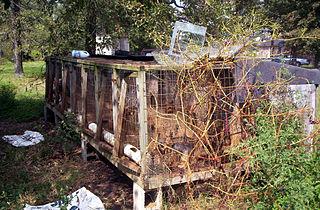
A puppy mill, also known as a puppy farm, is a commercial dog breeding facility characterized by quick breeding and poor conditions. Although no standardized legal definition for "puppy mill" exists, a definition was established in Avenson v. Zegart in 1984 as "a dog breeding operation in which the health of the mill’s dogs is disregarded to maintain a low overhead and maximize profits". They are cited as being a result of increased demand for household pets, especially after World War II. The Veterinary Medical Association of the Humane Society of the United States defines the main characteristics of a puppy mill as "emphasis on quantity over quality, indiscriminate breeding, continuous confinement, lack of human contact and environmental enrichment, poor husbandry, and minimal to no veterinary care."

The Cavalier King Charles Spaniel (CKCS) is a British breed of toy dog of spaniel type. Four colours are recognised: Blenheim, tricolour (black/white/tan), black and tan, and ruby; the coat is smooth and silky. The lifespan is usually between eight and twelve years.
A hide or skin is an animal skin treated for human use. The word "hide" is related to the German word Haut, which means skin. The industry defines hides as "skins" of large animals e.g. cow, buffalo; while skins refer to "skins" of smaller animals: goat, sheep, deer, pig, fish, alligator, snake, etc. Common commercial hides include leather from cattle and other livestock animals, buckskin, alligator skin and snake skin. All are used for shoes, clothes, leather bags, belts, or other fashion accessories. Leather is also used in cars, upholstery, interior decorating, horse tack and harnesses. Skins are sometimes still gathered from hunting and processed at a domestic or artisanal level but most leather making is now industrialized and large-scale. Various tannins are used for this purpose. Hides are also used as processed chews for dogs or other pets.
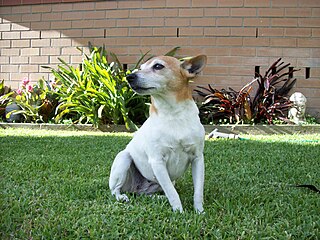
The Miniature Fox Terrier is a small, fine, lightweight working terrier developed as a hunting dog and vermin router. It is known colloquially in its native Australia as the “Mini Foxie”.
Rawhide is a hide or animal skin that has not been exposed to tanning. It is similar to parchment, much lighter in color than leather made by traditional vegetable tanning.

Teething is the process by which an infant's first teeth appear by emerging through the gums, typically arriving in pairs. The mandibular central incisors are the first primary teeth to erupt, usually between 6 and 10 months of age and usually causes discomfort and pain to the infant. It can take several years for all 20 teeth to complete the tooth eruption. Though the process of teething is sometimes referred to as "cutting teeth", when teeth emerge through the gums they do not cut through the flesh. Instead, hormones are released within the body that cause some cells in the gums to die and separate, allowing the teeth to come through.

A kennel is a structure or shelter for dogs. Used in the plural, the kennels, the term means any building, collection of buildings or a property in which dogs are housed, maintained, and bred. A kennel can be made out of various materials, the most popular being wood and canvas. The term "kennel" can also refer to a dog crate or doghouse.
Coccidiosis is a parasitic disease of the intestinal tract of animals caused by coccidian protozoa. The disease spreads from one animal to another by contact with infected feces or ingestion of infected tissue. Diarrhea, which may become bloody in severe cases, is the primary symptom. Most animals infected with coccidia are asymptomatic, but young or immunocompromised animals may suffer severe symptoms and death.

The health of dogs is a well studied area in veterinary medicine.

A hamster wheel or running wheel is an exercise device used primarily by hamsters and other rodents, but also by other cursorial animals when given the opportunity. Most of these devices consist of a runged or ridged wheel held on a stand by a single or pair of stub axles. Hamster wheels allow rodents to run even when their space is confined. The earliest dated use of the term "hamster wheel", located by the Oxford English Dictionary, is in a 1949 newspaper advertisement.
Littlest Pet Shop is a toy franchise and cartoon series owned by Hasbro and currently under license with Basic Fun!. The original toy series was produced by Kenner in the early 1990s. An animated television series was made in 1995 by Sunbow Productions and Jean Chalopin Creativite et Developpement, based on the franchise.
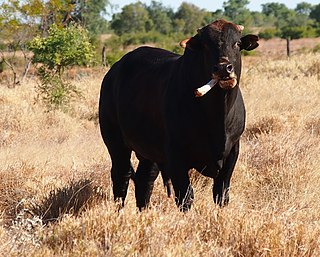
Osteophagy is the practice in which animals, usually herbivores, consume bones. Most vegetation around the world lacks sufficient amounts of phosphate. Phosphorus is an essential mineral for all animals, as it plays a major role in the formation of the skeletal system, and is necessary for many biological processes including: energy metabolism, protein synthesis, cell signaling, and lactation. Phosphate deficiencies can cause physiological side effects, especially pertaining to the reproductive system, as well as side effects of delayed growth and failure to regenerate new bone. The importance of having sufficient amounts of phosphorus further resides in the physiological importance of maintaining a proper phosphorus to calcium ratio. Having a Ca:P ratio of 2:1 is important for the absorption of these minerals, as deviations from this optimal ratio can inhibit their absorption. Dietary calcium and phosphorus ratio, along with vitamin D, regulates bone mineralization and turnover by affecting calcium and phosphorus transport and absorption in the intestine.
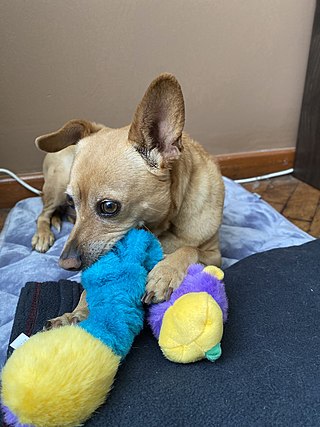
Toys specifically marketed for dogs to play with come in many varieties, including dog bones, puppy toys, balls, tug toys, training aids, squeaky toys, discs and frisbees, plush toys, and sticks.
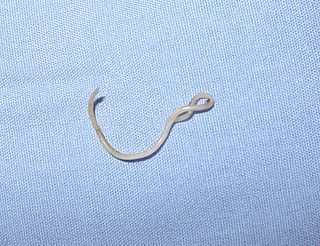
Toxocara canis is a worldwide-distributed helminth parasite that primarily infects dogs and other canids, but can also infect other animals including humans. The name is derived from the Greek word "toxon," meaning bow or quiver, and the Latin word "caro," meaning flesh. T. canis live in the small intestine of the definitive host. This parasite is very common in puppies and somewhat less common in adult dogs. In adult dogs, infection is usually asymptomatic but may be characterized by diarrhea. By contrast, untreated infection with Toxocara canis can be fatal in puppies, causing diarrhea, vomiting, pneumonia, enlarged abdomen, flatulence, poor growth rate, and other complications.
Lungworms are parasitic nematode worms of the order Strongylida that infest the lungs of vertebrates. The name is used for a variety of different groups of nematodes, some of which also have other common names; what they have in common is that they migrate to their hosts' lungs or respiratory tracts, and cause bronchitis or pneumonia. The lungworm will gradually damage the airways or lung tissue by inciting an inflammatory reaction inside the tissue. Ultimately, the parasites survive and reproduce in the respiratory tissues. The category is thus more a descriptive than a precisely taxonomic one.

Toxascaris leonina is a common parasitic roundworm found in dogs, cats, foxes, and related host species. T. leonina is an ascarid nematode, a worldwide distributed helminth parasite which is in a division of eukaryotic parasites that, unlike external parasites such as lice and fleas, live inside their host. The definitive hosts of T. leonina include canids and felines (cats), while the intermediate hosts are usually rodents, such as mice or rats. Infection occurs in the definitive host when the animal eats an infected rodent. While T. leonina can occur in either dogs or cats, it is far more frequent in cats.
Lumina Media was an American publisher of magazines, books, and associated websites. Throughout all its incarnations, the business has focused on the pet-keeping and -breeding market, though also with some other topical lifestyle and hobby publications. The original company was founded in 1974 as Fancy Publications by Norman Ridker, absorbing Kennel Club Books in 2004, which made BowTie a main competitor to TFH Publications in the pet-book market. In 2002, Bob Garfield of On the Media called Fancy Publications "the Time Warner of the pet magazine business". After some financial difficulties, BowTie was restructured as I-5 Publishing in 2013 under the new ownership of David Fry and Mark Harris, and took on its present name in 2016.

A tooth is a hard, calcified structure found in the jaws of many vertebrates and used to break down food. Some animals, particularly carnivores and omnivores, also use teeth to help with capturing or wounding prey, tearing food, for defensive purposes, to intimidate other animals often including their own, or to carry prey or their young. The roots of teeth are covered by gums. Teeth are not made of bone, but rather of multiple tissues of varying density and hardness that originate from the outermost embryonic germ layer, the ectoderm.

A hamster cage is an enclosure designed to house one hamster. It is recommended that hamster cages are at least 5000cm² for dwarf hamster except Roborovski and 6000cm² for syrian and Roborovski, although there is evidence that hamsters experience less stress if housed in larger cages. Commercially available pens are made of wire or plastic - both of which are unsafe for hamsters. Some pet owners house their hamsters in aquarium tanks, and some make their own pens out of wood or safe materials like plexi. Laboratory hamsters, commonly known as laboratory Syrian hamsters, are housed in pens designed for scientific use. There are also special pens designed for hamster shows.
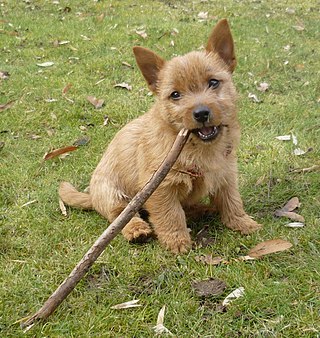
Puppies first start with sucking from the time of being a newborn up to the time they start teething. Puppies around the age of two weeks old start to experience teething. Teething is the process by which a puppy's deciduous teeth come in and then fall out to make way for their permanent teeth. By 5–6 weeks of life, all of the deciduous teeth have come in, puppies will grow in a set of 28 deciduous teeth or needle teeth. Permanent teeth will start coming in around 12–16 weeks, and puppies will eventually end up with 42 permanent teeth. The process of teething is painful to puppies much like babies. During this process puppies will experience increased salivation, loss of appetite, and extreme irritability when the teeth do erupt from the gums. The gums will swell and become tender to palpation just prior to the tooth coming in. Puppies may exhibit excessive chewing, nipping, and drooling. If there is an extreme change in behavior, it is recommended to visit the veterinarian as soon as possible for an exam. Owners that would like to do an oral exam on their own must be prepared for potential aggressive behavior.
















